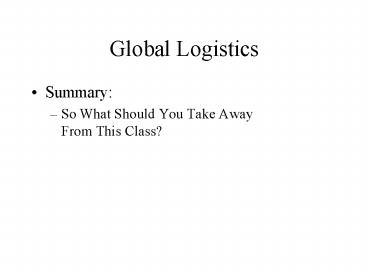Global Logistics - PowerPoint PPT Presentation
1 / 19
Title:
Global Logistics
Description:
Global Logistics Summary: So What Should You Take Away From This Class? Global Logistics Summary: So What Should You Take Away From This Class? The Global Corporation ... – PowerPoint PPT presentation
Number of Views:215
Avg rating:3.0/5.0
Title: Global Logistics
1
Global Logistics
- Summary
- So What Should You Take Away From This Class?
2
The Global Corporation
Fully integrates product design,
material supply, production, distribution,
accounting, marketing, and finance on a
world-wide basis. Typically design their
operating strategy objectives around four
components Technology, Marketing, Manufacturing,
and Logistics.
3
RETAIL INDUSTRY EXAMPLES
Geographic
C Q
C S
Sectorial
Functional
S Q
4
FORMS OF ALLIANCE
5
STRATEGIC IMPORTANCE
LEVEL OF COMMITMENT
6
(No Transcript)
7
To-Make or NOT To-Make?
Strategic Value of the Part in Isolation
Criticality of the Part to Final Assembly
8
Criteria Used by BOSE to Select Categories for
JIT II
1. There is a MATURE, TRUSTING Relationship with
the BEST Supplier in the Category. 2. The
Supplier has a GOOD ENGINEERING Capability. 3.
The Volume in the Product Category exceeds 1
Million. 4. The Product Category involves a lot
of TRANSACTIONS, creating a need for an
in-plant representative. 5. The Technology in
the Category is NOT changing at a Revolutionary
Pace. 6. The Category DOES NOT involve
Proprietary or Core Technologies (Such as
Acoustics and Electronics).
9
Activities Associated with Purchasing
10
VENDORS
PLANTS
DISTRIBUTION CENTERS
CUSTOMER ZONES
11
CENTRALIZATION Benefits
- Risk Pooling / Variance Reduction Effect
- Economies of Scale
- Economies of Scope
- Learning / Experience Curve
- Coordination Advantages
12
DECENTRALIZATION Benefits
- Product / Process Improvements
- - Proximity to suppliers
- Customer Satisfaction
- - Proximity to markets/customers
- Cost Savings
- - Sourcing, Production, Logistics
- - Financing
- Risk Diversification / Portfolio Effect
- - Technology Risk
- - Financial Risk
13
DOMESTIC vs GLOBAL LOGISTICS Logistics Elements
Inventory is Higher - Higher in-transit
inventories - Pipelines are longer and slower -
Higher Safety Stock levels - Longer lead times -
Political uncertainty - Production
uncertainties - More SKUs Facilities
Network More Difficult to Control - Several
languages and cultures - Labor norms -
Customs - Infrastructure
Transportation is More Difficult and Costly -
Freight rates - Intra-country transport -
Different modes - Complex documentation and
intermediaries - Consolidation Service is
Slower and More Costly - Lead times are longer -
Pipelines are longer - Uncertainty about
availability - Order processing is more
difficult - Stockouts are more frequent
14
FACTORS AFFECTING YOUR LOGISTICS ROLE
Economic Factors a) Type of Product
Product Life Cycle and Perishability
Strategic classification b) Nature of
Demand c) Proliferation of Products Environmenta
l Factors a) Level of Customer Service required
in the Market b) Routing Requirements c)
Host Governments Regulations and
Actions Organizational Factors a)
Marketing-Manufacturing Interface b)
Intra-Subsidiary Traffic and Accounting c) Strate
gic priorities (C,Q,S,F) and Metrics
15
ACTION PLAN
16
ADVANTAGES OF GLOBAL LOGISTIC
Rationalization of Resources Increase
Potential Market Size Economies of Scale and
Scope (i.e., minimization of Costs)
Flexibility Operational, Financial,
Responsiveness Improve Internal and External
Service Risk reduction through
diversification Technology Development and
RD (i.e., upgrading Quality) Faster
Response to the Dynamic Forces of the Global
Economy
17
1) Logistics is the natural link between
Operations and Marketing to make more
efficient the flow of goods and information along
the logistics system. Optimization of
individual linkages does not guarantee global
solutions and that is why you need a Global
Logistics Approach. e.g., Resource Oriented
Logistics, User Oriented Logistics , Information
Oriented Logistics 2) When determining and
forecasting future Demand, do not confuse
historical sales with Real Demand. Try to
incorporate substitution rates and information
about stockouts. When measuring service, dont
confuse individual measures with order
measures. e.g., mail orders versus POS
information link information with members of
the logistics system via EDI, ECR, CR and CFAR
line fill rate versus order fill rate 3) Not
all products (or customers) are equally
important. Classify products according to
logistics needs as well as financial indicators.
Proliferation of SKUs complicates the logistics
management. e.g., ABC versus ORG, clear rules
for introducing and retiring products from the
market
18
4) Outsourcing is a great alternative for
rationalizing the existing resources of a
company. However, do not outsource without
analyzing the strategic fit with the core
competence. e.g., strategic role of the part in
isolation versus strategic role of the part to
final assembly 5) 3PL companies are an
excellent alternative for outsourcing logistics.
However, make sure the needs as well as the
specific measurement is determined in
advance. e.g., show me the value measurement,
determination of the base case for comparison 6)
Cost, Quality, Service, and Flexibility are the
dimensions that allow for a better understanding
and management of the the logistics system.
There are at most two winning criteria and two
qualifying criteria. These criteria are dynamic
and change with the nature of competition. The
best alliances are the ones where your qualifying
criteria are your partners winning criteria.
19
The 4Ps of Operations and Logistics
P - COST
P-FLEXIBILITY
P-SERVICE
P - QUALITY































